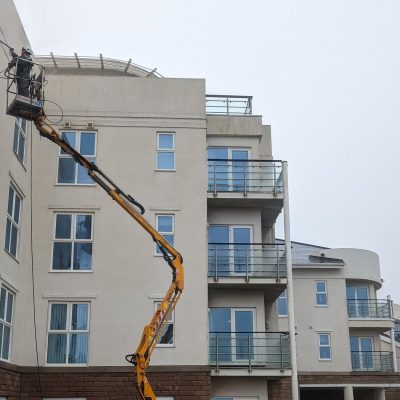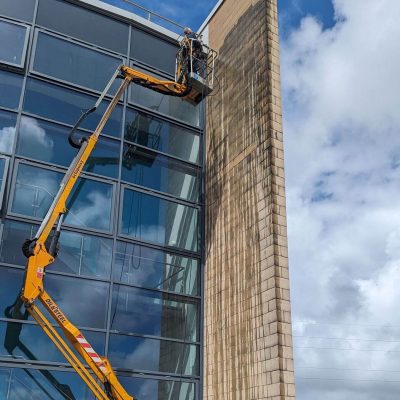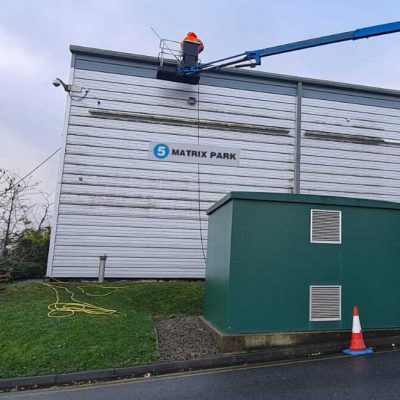Mobile Elevating Work Platforms (MEWPs) have become an indispensable tool in various industries, providing workers with a safe and efficient means to perform tasks at height. However, the safety of MEWP operators and the success of their work heavily rely on the proper assessment of ground conditions before and during operation. Failure to evaluate the suitability of the terrain can lead to accidents, injuries, and equipment damage.
Dangers of Using MEWPs on Poor Terrain
MEWPs are designed to provide temporary work platforms for people and equipment in elevated positions. When used correctly on solid, level ground, they provide safe and efficient access for tasks like construction, maintenance, inspection etc.
However, MEWPs rely on the stability of their outriggers and chassis to operate safely. If the ground gives way or machine sinks, the entire platform can become severely unbalanced and tip over.
Some of the dangers of using a MEWP on poor terrain could be:
- Sudden platform collapse if an outrigger sinks into soft or uneven ground. This can lead to falls from height for the operator and other occupants.
- Toppling over if the chassis tilts excessively on a slope. The raised platform exaggerates any instability, with forces magnifying significantly the higher it’s elevated.
- Getting stuck in mud or dirt, preventing safe operation and requiring specialist recovery.
- Damaging underground services if outriggers break through weak surfaces.
- Difficulty reaching the desired working position if unable to traverse rough terrain.
- Blocking emergency lowering if the chassis becomes grounded.
- Increased wear and tear from operating on unsuitable surfaces.
These risks can be eliminated by carefully checking the ground conditions in the proposed work area. And select the appropriate MEWP for that terrain.
Critical Factors to Assess
When evaluating ground suitability for MEWP use, there are several important factors you need to assess:
- Terrain type
- Strength and firmness
- Compaction
- Slope/gradient
- Presence of hazards
- Previous disturbance
- Drainage
- Vehicle access
- Weather effects
- Seasonal changes
Thoroughly assessing these factors, you can determine if the ground has adequate stability for MEWP use or if additional precautions are required.
Carrying Out a Ground Condition Survey
The best way to evaluate the suitability of terrain for MEWP use is to carry out a dedicated ground condition survey of the work area.
This involves a physical inspection of the site and systematic checks for each of the key factors listed above. To conduct an effective survey:
- Review proposed work area – Check site plans and maps to understand the geography, vegetation, structures and services.
- Inspect on foot – Walk the site to closely inspect surface characteristics. Check for slope, compaction, and hazards. Look for signs of subsidence or waterlogging.
- Drive access route – Attempt to drive the route as if accessing the work area with a machine. If the ground appears weak, stop and assess further.
- Test suspect areas – Prod soil with rod to check stability. Drive across grassy areas, look for vehicle tracks sinking in.
- Check after rain – Previous dry ground can become treacherous when wet.
- Consider all lift positions – Assess not just the access route but also the specific positions lifts will occupy when working.
- Look for underground hazards – Review utility plans for services, bases of old structures, filled trenches etc.
- Refer to GEOTECH surveys – Commission specialist ground surveys if the area appears problematic or hazardous. Survey should identify any sections of ground that are unsuitable for MEWP access in their present condition.
- Document findings – Record details through notes, photographs and marking up site maps.
Ground Pressure Considerations
A key factor in assessing ground suitability is evaluating the pressure exerted through the MEWP’s wheels, chassis and outriggers. This is referred to as ‘ground bearing pressure’ or ‘ground pressure’.
The ground pressure determines how much the equipment will sink into the surface when loaded:
- Higher ground pressure = more sinking and instability
- Lower ground pressure = less penetration and better support
Certain soil types have a maximum bearing capacity before they fail. Exceeding this capacity causes sudden collapse as the soil particles shift and separate under the load.
Slope & Stability Issues
Slopes and uneven ground significantly affect MEWP stability. As the gradient increases, forces acting to destabilise the unit also increase.
Specific risks on sloping ground include:
- Side friction between chassis and soil, causing sliding downslope
- Downward force encouraging sinking into softer surfaces
- Increased risk of lateral overturning, especially during motion
- Level sensor errors giving false outrigger grounded alerts
- Chassis canting over if outriggers extend across slopes
- Reduced stability as the platform elevates due to shift in centre of gravity
Effects of Weather and Moisture
Weather & moisture content are critical factors influencing ground stability. Soil strength and firmness can change significantly with:
- Water saturation from heavy rain, flooding, groundwater table rise or leaky services.
- Drying and cracking of clay soils during hot, dry periods.
- Freeze-thaw action on silty soils during winter.
- Snow cover hiding weaknesses like animal burrows.
- Vegetation growth between uses altering support.
- Varying moisture at different soil depths.
Always assess ground suitability under the worst anticipated conditions. Avoid use on marginal sites after heavy rain until suitable drainage occurs.
Plan additional checks after long periods of disuse or changing seasons. Ground stable in summer may not support MEWPs in winter.
Hazards with Various Terrain Types
Different natural and man-made ground materials present specific hazards for MEWP use, including:
- Hard standings
- Grass, soil and gravel
- Made up ground
- Agricultural land
- Paving and blocks
- Indoor floors
Mitigation Options to Improve Ground Conditions
If ground conditions appear inadequate during survey, there are ways to improve stability and allow safer MEWP access:
- Spreader plates
- Temporary surfaces
With planning and preparation, sites can often be made accessible for MEWPs. But if in doubt, don’t proceed until ground conditions are improved. For more details click here.
Documenting the Survey Findings
Fully document the ground survey findings so you can demonstrate suitable precautions were taken.
- Take photos of the terrain from the access route to work sites.
- Record any questionable areas and assess further.
- Note tests done e.g. prodding soil, driving across area.
- Mark-up site map showing off-limit zones, access paths and lift locations.
- Keep weather records to relate condition changes.
- Detail any mitigation measures employed.
- Log the survey timing and personnel involved.
- Attach GEOTECH or penetrometer test reports if applicable.
Having a written ground condition assessment procedure as part of your lift safety program is highly recommended.
Summary of Key Ground Assessment Steps
To conclude, inspecting ground conditions is a vital safety step before MEWP deployment. Follow these best practices:
- Check proposed work areas using plans, maps and visual inspection.
- Survey on foot after heavy rain to see the worst conditions.
- Drive the access route where possible to test stability.
- Look for slopes, soft spots, voids and hazards.
- Evaluate soil type, compaction, and penetrometer readings.
- Consider weather effects, moisture infiltration and season changes.
- Compare ground pressures to soil bearing capacity.
- Check lift manufacturer limits for slope, ground condition.
- Use mitigations if needed.
- Fully document findings and prohibit unsafe zones.
- Ensure surveyors are properly trained.



